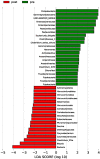Gut microbiota of liver transplantation recipients
- PMID: 28630433
- PMCID: PMC5476624
- DOI: 10.1038/s41598-017-03476-4
Gut microbiota of liver transplantation recipients
Abstract
The characteristics of intestinal microbial communities may be affected by changes in the pathophysiology of patients with end-stage liver disease. Here, we focused on the characteristics of intestinal fecal microbial communities in post-liver transplantation (LT) patients in comparison with those in the same individuals pre-LT and in healthy individuals. The fecal microbial communities were analyzed via MiSeq-PE250 sequencing of the V4 region of 16S ribosomal RNA and were then compared between groups. We found that the gut microbiota of patients with severe liver disease who were awaiting LT was significantly different from that of healthy controls, as represented by the first principal component (p = 0.0066). Additionally, the second principal component represented a significant difference in the gut microbiota of patients between pre-LT and post-LT surgery (p = 0.03125). After LT, there was a significant decrease in the abundance of certain microbial species, such as Actinobacillus, Escherichia, and Shigella, and a significant increase in the abundance of other microbial species, such as Micromonosporaceae, Desulfobacterales, the Sarcina genus of Eubacteriaceae, and Akkermansia. Based on KEGG profiles, 15 functional modules were enriched and 21 functional modules were less represented in the post-LT samples compared with the pre-LT samples. Our study demonstrates that fecal microbial communities were significantly altered by LT.
Conflict of interest statement
The authors declare that they have no competing interests.
Figures






Similar articles
-
Colonizing multidrug-resistant bacteria and the longitudinal evolution of the intestinal microbiome after liver transplantation.Nat Commun. 2019 Oct 17;10(1):4715. doi: 10.1038/s41467-019-12633-4. Nat Commun. 2019. PMID: 31624266 Free PMC article.
-
Functional Microbiomics in Liver Transplantation: Identifying Novel Targets for Improving Allograft Outcomes.Transplantation. 2019 Apr;103(4):668-678. doi: 10.1097/TP.0000000000002568. Transplantation. 2019. PMID: 30507741 Free PMC article. Review.
-
Characteristics of fecal microbial communities in patients with non-anastomotic biliary strictures after liver transplantation.World J Gastroenterol. 2017 Dec 14;23(46):8217-8226. doi: 10.3748/wjg.v23.i46.8217. World J Gastroenterol. 2017. PMID: 29290658 Free PMC article.
-
Fecal Microbiome Data Distinguish Liver Recipients With Normal and Abnormal Liver Function From Healthy Controls.Front Microbiol. 2019 Jul 3;10:1518. doi: 10.3389/fmicb.2019.01518. eCollection 2019. Front Microbiol. 2019. PMID: 31333622 Free PMC article.
-
The Role of Microbiota in Liver Transplantation and Liver Transplantation-Related Biliary Complications.Int J Mol Sci. 2023 Mar 2;24(5):4841. doi: 10.3390/ijms24054841. Int J Mol Sci. 2023. PMID: 36902269 Free PMC article. Review.
Cited by
-
Gut microbiota influence on lung cancer risk through blood metabolite mediation: from a comprehensive Mendelian randomization analysis and genetic analysis.Front Nutr. 2024 Sep 11;11:1425802. doi: 10.3389/fnut.2024.1425802. eCollection 2024. Front Nutr. 2024. PMID: 39323566 Free PMC article.
-
Impact of infection on transplantation tolerance.Immunol Rev. 2019 Nov;292(1):243-263. doi: 10.1111/imr.12803. Epub 2019 Sep 19. Immunol Rev. 2019. PMID: 31538351 Free PMC article. Review.
-
Colonizing multidrug-resistant bacteria and the longitudinal evolution of the intestinal microbiome after liver transplantation.Nat Commun. 2019 Oct 17;10(1):4715. doi: 10.1038/s41467-019-12633-4. Nat Commun. 2019. PMID: 31624266 Free PMC article.
-
Functional Microbiomics in Liver Transplantation: Identifying Novel Targets for Improving Allograft Outcomes.Transplantation. 2019 Apr;103(4):668-678. doi: 10.1097/TP.0000000000002568. Transplantation. 2019. PMID: 30507741 Free PMC article. Review.
-
Editorial: The Microbiome in Hepatobiliary and Intestinal Disease.Front Physiol. 2022 Apr 13;13:893074. doi: 10.3389/fphys.2022.893074. eCollection 2022. Front Physiol. 2022. PMID: 35492588 Free PMC article. No abstract available.
References
Publication types
MeSH terms
Substances
LinkOut - more resources
Full Text Sources
Other Literature Sources
Medical

